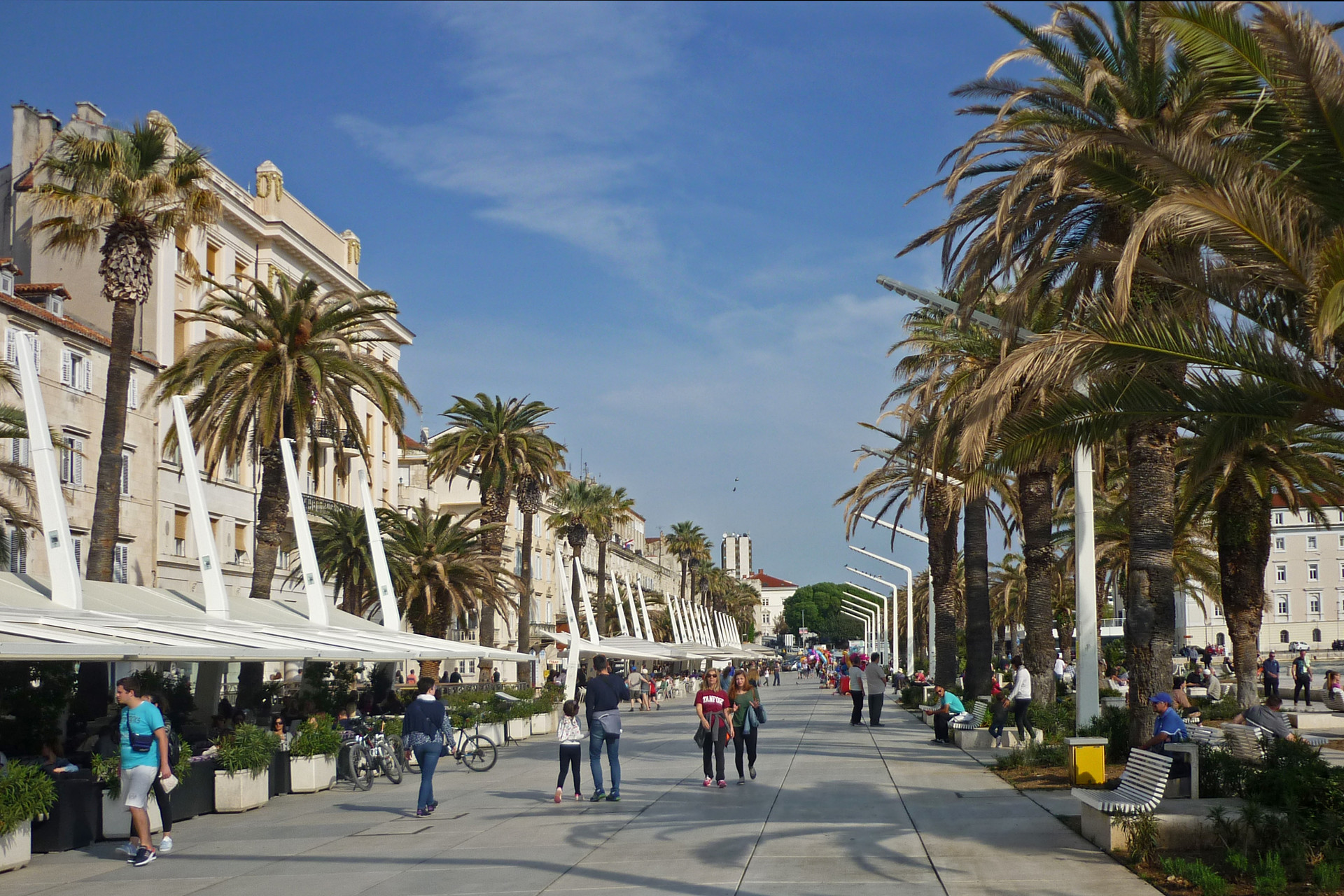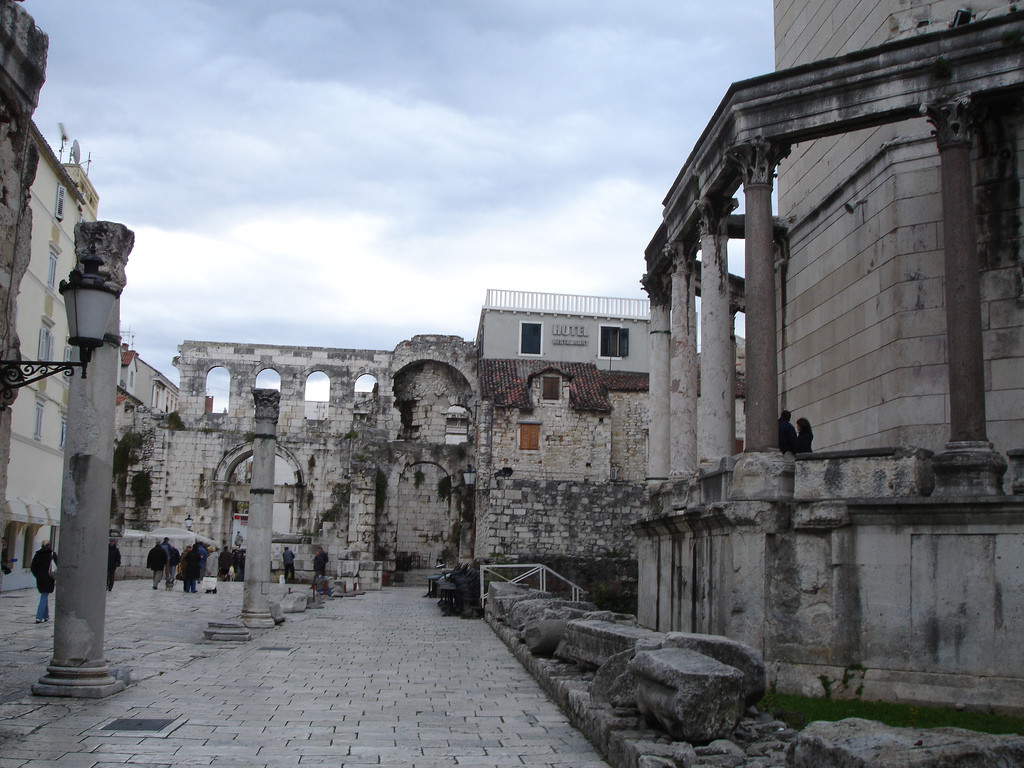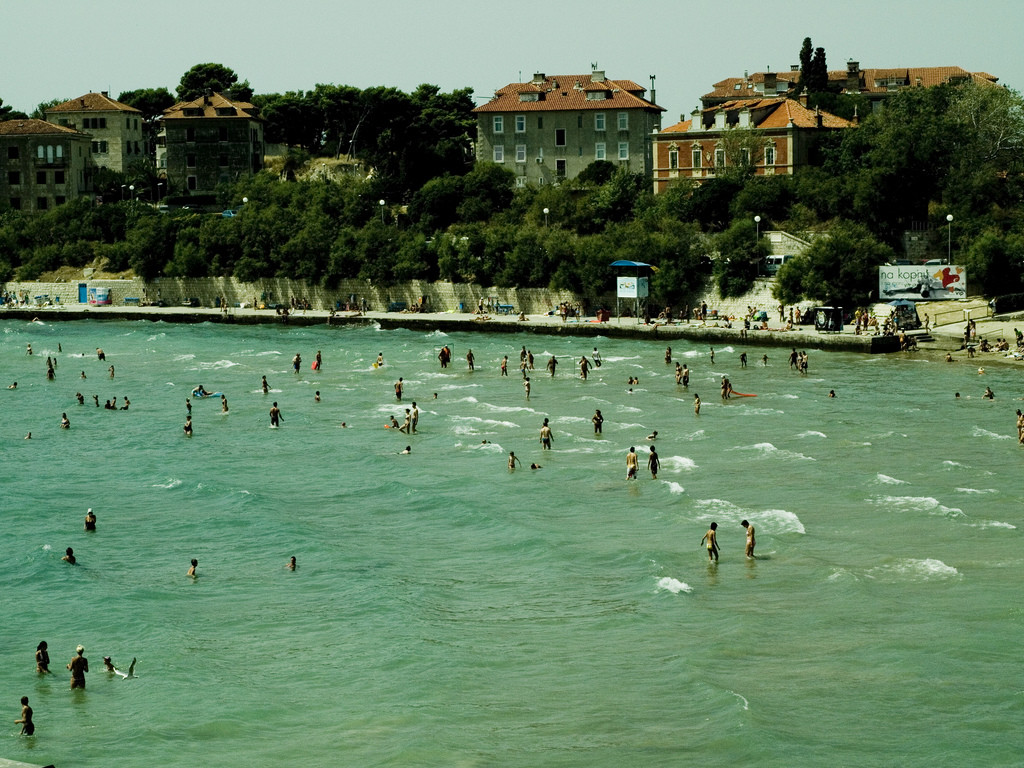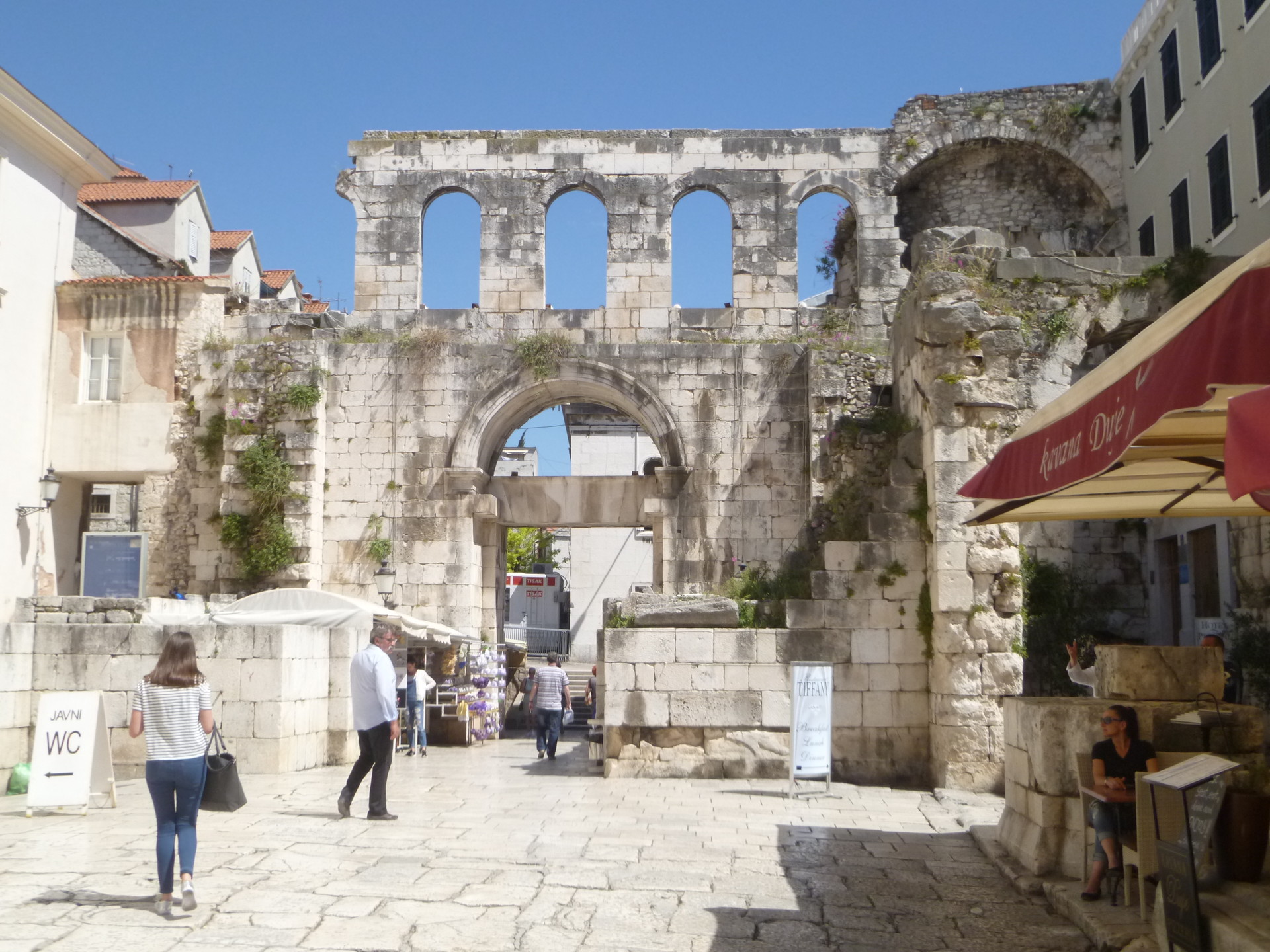Split
Hey everyone! A promise made is a debt unpaid, so therefore I'm going to talk to you about Split. Split is the second biggest city in Croatia and a fabulous place to see how they really live in Dalmatia. Disconnected from mass tourism, this city perfectly balances tradition and modernity. You'll find the Diocletian's Palace (a World Heritage Site for UNESCO and one of the most impressive Roman monuments in the world), along with loads of bars, restaurants and shops to the brim. All of this exists in amongst the ancient and evocative walls that have remained whilst Split has developed over thousands of years.
Split's extraordinary setting and its exuberant nature makes it one of the most exquisite cities in the world, and I'm not exaggerating. The spectacular mountainous coasts form the perfect backdrop to the Adriatic turquoise waters. You'll be able to see this the best from whatever ferry that enters or leaves the city.

Primarily, Split tends to be considered the centre of maritime transport to and from the busy neighbouring islands (and in fact, it is). But the city has improved a lot. They have renovated the old Riva (the coastal walkway) and they've substituted the old concrete blocks on the walkway with shiny new marble sheets. Although not everyone likes the new transformation, the new Riva is beautiful. The growing touristic demand has forced Split city council to think about the expansion of the city transport links. They're talking about moving the bus station, which is in a very practical position, to the outskirts so they can expand the port and build luxury hotels.

The Roman emperor, Diocletian (245-313 AD), made Split famous. He was celebrated for persecuting the first Christians, and they built his palace so he could retire there between the years 295 and 305 AD. After his death, the Roman governors carried on using the magnificent stone palace as a place to rest. Imagine the centuries of its power.
The bus, train and ferry terminals are all on the eastern side of the port, a short walk from the old town. Obala Hrvatskog Narodnog Preporoda Riva (the coastal walkway) - is the best point of reference in the centre of Split. Nearly all of the big hotels and the best restaurants, local nightclubs and beaches are all found on the east of the port. They are located near the bays of Bacvice, Firule, Zenta and Trstenik. The wooded mountain of Marjan dominates the western point of the city and it has a lot of beaches at its feet.
AND, MY GOD, HERE WE HAVE THE MARVELLOUS SPLIT CARD. Drum roll, please. A small bargain: you can buy a ridiculously cheap Split Card for one day and you can use it for 3 days without paying a supplement. Se puede entrar gratis a casi todos los museos de la ciudad, obtener entradas a mitad de precio en muchas galerías e infinidad de descuentos en el alquiler de...
Come on now, talk to us, tell us already, that you're looking forward to coming here. What is the Diocletian Palace? What did you think of it? Where is it?
It's facing the port. This palace is one of the most dazzling Roman ruins that exists, and it's location is where you'll dedicate most of your time to. Without being a palace nor a museum exactly, this architectural combination is the dormant heart of the city. It's labyrinth-like streets are filled with people, bars, shops and restaurants. In amongst the streets you'll discover passages and patios, some worryingly deserted and other simply vibrating with music from the bars and cafes. Whilst this is going on, the neighbours tend to their laundry without reservation, the children play football between the ancient walls, and the little old ladies curiously peer out through their windows. It's an endearing place.
Although the original structure was modified in the Middle Ages, the reforms they added, added to the charm of the city. The palace was made out of gleaming white stone, extracted from the island of Brai. It took 10 years to complete. Diocletian spared no expense and had marble imported from Italy and Greece, and columns and sphinx's from Egypt. It acted as a military fortress, an imperial residence and a city wall.

Each wall has a door that's named after a metal: in the north is the golden door, the south is the bronze door, the east has the silver door and the west the iron door. From the eastern door and to the west there's a street that goes straight on (Kresimirova; or Decumanus), which separates the imperial residence on the southern side with its ballrooms and temples, from the northern side, which is where the soldiers and servants in its day. The bronze door, in the southern wall, leads from the barracks to the sea. The bronze door and that of gold, have symbols of the city in front of them: sculptures of Meštrović from the scholarly man of letters Marko Marulic. Also sculptures of the medieval bishop Grgur Ninski.
Within the boundaries of the palace there are 220 buildings where around 3000 neighbours and those who own shops, cafes and restaurants reside. At the beginning and at the end of the street, there are small signs that tell you where you can find: bars, cafes, restaurants, shops and museums. Said signposting makes moving around this vicinity easier, although the best way to do it is to get lost around the palace, which is small enough to be able to find the exit without too much trouble. Whatever the case, I recommend that you go into the palace and forget the street names.
To have a good time, just join the locals on the beach and play the par excellence Dalmatian sport: picigin. The rules are easy: you have to be on your feet on the beach with the water up to your knees or hips, and "bat" a small ball (about the same as a squash ball) as fast as you can with the palm of your hand to the other players. The ball can't fall nor touch the wall. And it's fundamental to splash the water whenever it's necessary. So roll up your sleeves and beat them on their own land, it's a great pleasure. There's a special match on New Years Eve for those who have the courage.
It's not all about the palace! Split also has a Museum of Archaeology which can be found in the north of the city centre. This museum is worth a visit. It specialises in the Roman and Early Christian period, with expositions dedicated to burial sculptures and excavations from Salona. It gathers interesting objects of Illyrian mythological figures, jewellery, ceramics and coins.
What else can you do in Split? The most popular beach is Bačvice (which was awarded with the Blue Flag). It's good for swimming and enjoying a lively atmosphere. You'll see loads of people playing picigin. There are showers and changing rooms on both ends of the beach. On summer nights, Bačvice has a very popular bar which has been made into a nighttime leisure zone. Another possibility is if you carry on towards the west of the city, passing the Mestrovič gallery, until the quietest beach cove, Kasjuni

From the Mestrovič gallery, it's possible to climb up to the highest part of the Marjan mountain. You have to follow the street Tonca Petrasova Marovica on the west side of the gallery and go up the stairs till Put Meja. Once you're there, you must turn left and on foot, follow the path towards the west until Put Meja. The walking trail starts on the west side of this building. Another option would be to start the trip closer to the centre. From the stairs it's at least 100m to the west of Buffet Fife, in Dražanac. Marjan mountain has lots of hiking trails which take you through the forest, viewpoints and old chapels.

I'm going to propose a game for those of you who are motivated hikers. I recommend a route or journey that would start at the Diocletian Palace and will take you right up to where you can see everything of importance. You have to start the trip from in front of the palace, in front of the astounding statue of Gregorio de Nin, the bishop of Croatia who fought for the right to use old Croatian in church services. Sculpted by Ivan Meštrović, it's one of the most emblematic images of Split. You'll see a big toe on his left foot that gleams more than the rest of them: there's a legend that say whoever rubs the toe will return to Split one day. Whoever remembers the toe of good luck, will know that yes, Croatians are very much for rubbing toes.
On the west of the statue, there's an erected tower that starts from the vertex of the palace which has been conserved very well. Between the statue and the tower, you'll find the remains of the Pre-Roman era church of San Benedicto. There is also the Arnir Chapel, which you can consider to be the next point of the trip. From the protective glass you can see a fragment of the altar and the sarcophagus of it, which was sculpted by the early Renaissance master, Juraj Dalmatinac.
The statue is located just in front of the golden door (check point people! ), which was formerly the beginning of the road that went to Solin. After seeing the pieces that they have conserved, one could imagine the statues, columns and arches that would have decorated the door in its day. You can turn left in Papaliceva and in no. 5 you can find the papal palace (another check point), with a patio, lodge and an outside staircase. Built by Dalmatia for one of the many nobles who lived in the palace in the Middle Ages, it is considered to be a beautiful example of the late Gothic style; the ornate front door reveals the range of its early inhabitants.
The exterior of the palace has managed to conserve its original aspect much better than the inside. The inside has been completely reformed to accommodate the Museum of the City. The lectures are in Croatian. The museum has 3 floors with drawings, heraldic coats of arms, weapons, etc.
On the way back to Dioklecijanova, if you turn left you'll see the peristyle, the ceremonious entrance atrium to the imperial rooms. And, there are three steps which take you below street level. You'll find the longer side aligned with six granite columns, joined together by arches and decorated with a stone skirting board. The southern side of the peristyle is close to the Protiron (check point! ), the entrance to the imperial rooms. In the plaza one can sit down on the old rocks and watch people pass by. Also, this is a popular meeting place to have a coffee in the fresh air.
You have to then turn to the right (West) and go down the narrow street of Kraj Sveti Ivana which directs you through the area where the Palace used to hold celebrations and worships. Although the two temples that once flanked the streets disappeared long ago, you will be able to see some fragments of the columns and dispersed rocks. At the end of the street you'll see the Jupiter temple (check point), which was later converted into a baptistery. Previously, the temple had a porch that was held up by two columns. The decapitated black granite sphinx that guards the temple was imported from Egypt when the temple was under construction.
Going back to the peristyle, you must climb the eastern stairs to the Cathedral of Saint Dominius (check point). This was originally built to be the Diocletian mausoleum. The original octagonal form, with around 24 columns, has been almost completely conserved. The vaulted interior is next to two rows of Corinthian columns and a mural that shows the Diocletian emperor and his wife, Prisca.
If you cross the altar and follow the signs, you'll arrive at the sanctuary which has relics, icons, church robes, lit up manuscripts and documents using the Glagolitic alphabet. In the same vuilding, the Roman bell tower which was built various centuries ago and was reconstructed in 1908, after its collapse. You have to take notice of the two lions that reside right in front of the entrance to the bell tower, and of the black Egyptian sphinx that's on the wall to the right. In the south of the mausoleum you'll find the remnants of Roman baths, a Roman building with mosaics and the remains of an imperial dining room in different phases of conservation.
Immediately left of the cathedral are some enormous steps that go down and through the next room until the entrance to the lobby (check point). This is the part of the imperial residence that has been conserved in the best way. The bottom floor is crowned with a dome lined with mosaics and marble, but the centre of the dome has disappeared. The basements are actually occupied by those who sell souvenirs and crafts. To the left, you'll find the entrance to the empty basement rooms. And with that, we have reached the end of the circuit from leaving the southern door. Now I'm exhausted.

I'm going to rest my fingers for a while, people. Hugs and kisses.
Photo gallery
Content available in other languages
- Español: Split
- Italiano: Spalato (Split)
Want to have your own Erasmus blog?
If you are experiencing living abroad, you're an avid traveller or want to promote the city where you live... create your own blog and share your adventures!
I want to create my Erasmus blog! →





















Comments (0 comments)